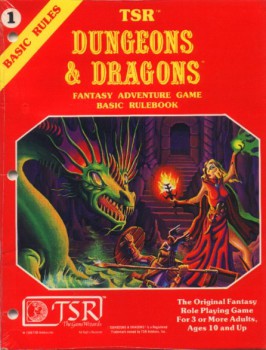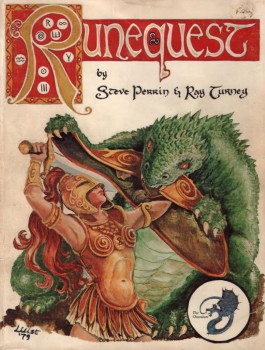Sea-Change
 Fantasy literature and Dungeons & Dragons have a long history together. In his foreword to the original edition of the game (dated November 1, 1973), Gary Gygax specifically references several authors’ works, such as “Burroughs’ Martian adventures where John Carter is groping through black pits,” “Howard’s Conan saga,” “the de Camp & Pratt fantasies,” and “Fritz Leiber’s Fafhrd and the Gray Mouser pitting their swords against evil sorceries.” There are also – or, rather, were – references to Tolkien as well, but these were excised after the Professor’s estate objected (the excisions were not very thorough; even in later printings, one can still find occasional references to ents and balrogs, among other things). My own beloved “Blue Book” edition of D&D (edited by J. Eric Holmes) includes references not only to Tolkien, Howard, and Leiber, but also to Gardner F. Fox, creator of Alan Morgan, Kothar, and Kyrik, as well as to H.P. Lovecraft’s Great Old One, Cthulhu.
Fantasy literature and Dungeons & Dragons have a long history together. In his foreword to the original edition of the game (dated November 1, 1973), Gary Gygax specifically references several authors’ works, such as “Burroughs’ Martian adventures where John Carter is groping through black pits,” “Howard’s Conan saga,” “the de Camp & Pratt fantasies,” and “Fritz Leiber’s Fafhrd and the Gray Mouser pitting their swords against evil sorceries.” There are also – or, rather, were – references to Tolkien as well, but these were excised after the Professor’s estate objected (the excisions were not very thorough; even in later printings, one can still find occasional references to ents and balrogs, among other things). My own beloved “Blue Book” edition of D&D (edited by J. Eric Holmes) includes references not only to Tolkien, Howard, and Leiber, but also to Gardner F. Fox, creator of Alan Morgan, Kothar, and Kyrik, as well as to H.P. Lovecraft’s Great Old One, Cthulhu.
By now, Appendix N of the Dungeon Masters Guide is well known, both on this site and elsewhere. What many people do not know is that Gygax produced a “rough draft” of that appendix in issue number 4 of Dragon magazine (December 1976). Entitled “Fantasy/Swords & Sorcery: Recommended Reading,” its content is roughly the same as that in Appendix N. It’s primarily noteworthy for including Algernon Blackwood, though Gygax makes no reference to any titles he recommends from this great British writer of ghost tales. Another interesting aspect, at least from my perspective, is that, unlike Appendix N, which is quite clearly presented as a list of the books Gygax himself found “of particular inspiration” (to borrow his own phrase once more), this early version is presented as one of “recommended reading,” as if he were an instructor drawing up a list for an Introduction to Fantasy Literature course.
Fascinatingly enough, the 1981 edition of Dungeons & Dragons, edited by Tom Moldvay, includes an extensive “Inspirational Source Material” section that was drawn up, not by a university professor, but by a children’s librarian at the Lake Geneva Public Library. This librarian, Barbara Davis, is given a “special thanks” citation in the rulebook’s credits for “compiling part of our bibliography.”
Though it’s quite possible, even likely, that many of the titles included in the 1981 list were inspirational to Moldvay or to other members of the editorial team at TSR Hobbies, its presentation is much different than that of Appendix N. Whereas Gygax simply lists his favorite authors in alphabetical order, the later list is divided into several categories in an almost scholarly fashion. The three largest sections are “Fiction: Young Adult Fantasy,” “Non-Fiction: Young Adult,” and “Fiction: Adult Fantasy.” There are also sections for “Short Story Collections” and “Non-Fiction,” as well as a list of “some additional authors of fantasy fiction.”
